Related Research Articles

Bodybuilding is the use of progressive resistance exercise to build, control, and develop one's muscles via hypertrophy. An individual who engages in this activity is referred to as a bodybuilder. It is primarily undertaken for aesthetic purposes over functional ones, distinguishing it from similar activities such as powerlifting, which focuses solely on gaining physical strength.
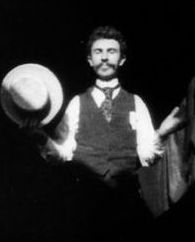
William Kennedy Laurie Dickson was a British inventor who devised an early motion picture camera under the employment of Thomas Edison.
The following is an overview of the events of 1894 in film, including a list of films released and notable births.

The biceps or biceps brachii is a large muscle that lies on the front of the upper arm between the shoulder and the elbow. Both heads of the muscle arise on the scapula and join to form a single muscle belly which is attached to the upper forearm. While the biceps crosses both the shoulder and elbow joints, its main function is at the elbow where it flexes the forearm and supinates the forearm. Both these movements are used when opening a bottle with a corkscrew: first biceps screws in the cork (supination), then it pulls the cork out (flexion).

The Kinetoscope is an early motion picture exhibition device, designed for films to be viewed by one person at a time through a peephole viewer window. The Kinetoscope was not a movie projector, but it introduced the basic approach that would become the standard for all cinematic projection before the advent of video: it created the illusion of movement by conveying a strip of perforated film bearing sequential images over a light source with a high-speed shutter. First described in conceptual terms by U.S. inventor Thomas Edison in 1888, it was largely developed by his employee William Kennedy Laurie Dickson between 1889 and 1892. Dickson and his team at the Edison lab in New Jersey also devised the Kinetograph, an innovative motion picture camera with rapid intermittent, or stop-and-go, film movement, to photograph movies for in-house experiments and, eventually, commercial Kinetoscope presentations.
In human anatomy, a hamstring is any one of the three posterior thigh muscles in between the hip and the knee. The hamstrings are susceptible to injury.

Louis Cyr was a Canadian strongman with a career spanning the late 19th and early 20th centuries. His recorded feats, including lifting 500 pounds (227 kg) with one finger and backlifting 4,337 pounds (1,967 kg)(2 tons), show Cyr to be, according to former International Federation of BodyBuilding and Fitness chairman Ben Weider as stated in 2000, the strongest man ever.
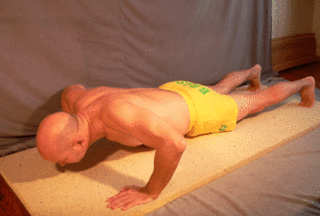
The push-up is a common calisthenics exercise beginning from the prone position. By raising and lowering the body using the arms, push-ups exercise the pectoral muscles, triceps, and anterior deltoids, with ancillary benefits to the rest of the deltoids, serratus anterior, coracobrachialis and the midsection as a whole. Push-ups are a basic exercise used in civilian athletic training or physical education and commonly in military physical training. They are also a common form of punishment used in the military, school sport, and some martial arts disciplines. Variations of push-ups, such as wide-arm push-ups, diamond push-ups target specific muscle groups and provide further challenges.
Bicep curls are a group of weight training exercises in which a person bends their arm towards their body at the elbow in order to make their biceps stronger.
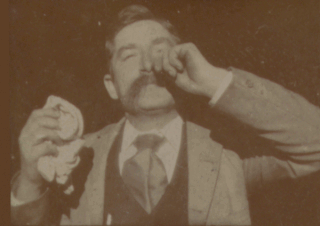
Fred Ott's Sneeze is an 1894 short, black-and-white, silent film shot by William K.L. Dickson and featuring Fred Ott. It is the oldest surviving motion picture with a copyright.

Eugen Sandow was a German bodybuilder and showman from Prussia. Born in Königsberg, Sandow became interested in bodybuilding at the age of ten during a visit to Italy. After a spell in the circus, Sandow studied under strongman Ludwig Durlacher in the late 1880s. On Durlacher's recommendation, he began entering strongman competitions, performing in matches against leading figures in the sport such as Charles Sampson, Frank Bienkowski, and Henry McCann. In 1901 he organised what is believed to be the world's first major bodybuilding competition. Set in London's Royal Albert Hall, Sandow judged the event alongside author Sir Arthur Conan Doyle and athlete/sculptor Charles Lawes-Wittewronge.


Vitascope was an early film projector first demonstrated in 1895 by Charles Francis Jenkins and Thomas Armat. They had made modifications to Jenkins' patented Phantoscope, which cast images via film and electric light onto a wall or screen. The Vitascope is a large electrically-powered projector that uses light to cast images. The images being cast are originally taken by a kinetoscope mechanism onto gelatin film. Using an intermittent mechanism, the film negatives produced up to fifty frames per second. The shutter opens and closes to reveal new images. This device can produce up to 3,000 negatives per minute. With the original Phantoscope and before he partnered with Armat, Jenkins displayed the earliest documented projection of a filmed motion picture in June 1894 in Richmond, Indiana.
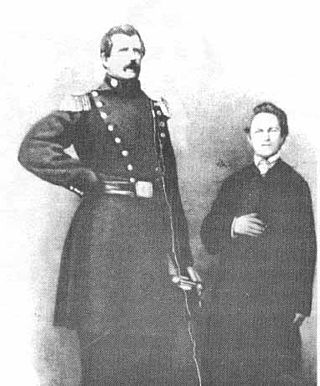
In the 19th century, the term strongman referred to an exhibitor of strength or similar circus performers who performed feats of strength. Today, strength athletics, also known as strongman competitions, are composed of a variety of events in which competitors have to move the highest weights possible, the winner being the one having the highest tally across all events.

The pull-down exercise is a strength training exercise designed to develop the latissimus dorsi muscle. It performs the functions of downward rotation and depression of the scapulae combined with adduction and extension of the shoulder joint.
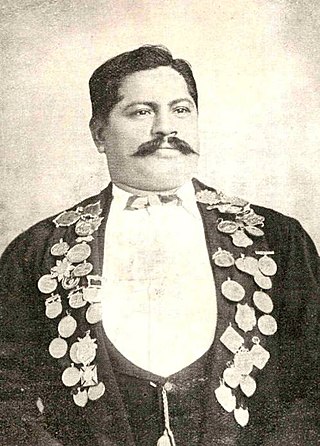
Kodi Rammurthy Naidu was an Indian strongman, bodybuilder, wrestler and an important figure in India’s physical culture history. He was renowned for his strength and physical prowess and for feats such as stopping two cars using his muscle power and taking an elephant on his chest. He was awarded the title of "Indian Hercules" by King George V. He is also known by the epithets "Kaliyuga Bhima", "Indian Sandow", "Malla Marthanda".
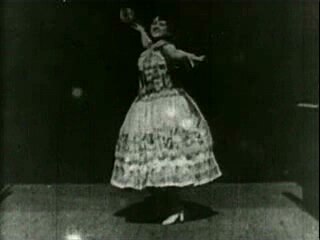
Carmencita is an 1894 American short black-and-white silent documentary film directed and produced by William K.L. Dickson, the Scottish inventor credited with the invention of the motion picture camera under the employ of Thomas Edison. The film is titled after the dancer who features in it.
The decade of the 1890s in film involved some significant events.

Monte Saldo was an early bodybuilder who later, with his brothers Frank Saldo and Edwin Woollaston, formed the stage act The Montague Brothers, in which they displayed acts of strength including supporting a heavy motor car complete with passengers. With Maxick, he developed the Maxalding system of muscle control.

Al Treloar was an American bodybuilder, athletic trainer, author and artist's model. He won the first international bodybuilding contest in 1904, appeared in early silent films, and toured the United States as a vaudeville performer. He was physical director at the Los Angeles Athletic Club from 1907 to 1949.
References
- ↑ "Souvenir Strip of the Edison Kinetoscope". Film Threat . Retrieved 2008-04-20.
The film began with Sandow holding his hands behind his head, enabling a conspicuous bit of biceps flexing and abs display. (Speaking of display, Sandow's posing shorts left very, very little to the imagination.) Sandow then folded his arms across his meaty chest, followed by a modified version of the crab pose that enabled another view of his abs while showing off his forearms. After a quick single biceps pose, Sandow turned around for a lat spread, showing off a ridiculously well-developed back. After a few stretching exercises, Sandow turned back to the camera and repeated his poses.